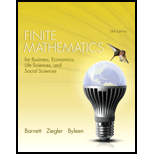
Show that
Discuss the generalization of this result to any absorbing Markov chain with two absorbing states and one nonabsorbing state.
Want to see the full answer?
Check out a sample textbook solution
Chapter 9 Solutions
Finite Mathematics for Business, Economics, Life Sciences, and Social Sciences (13th Edition)
Additional Math Textbook Solutions
Elementary Statistics: Picturing the World (7th Edition)
Calculus: Early Transcendentals (2nd Edition)
Elementary Statistics (13th Edition)
Basic Business Statistics, Student Value Edition
Elementary Statistics
Thinking Mathematically (6th Edition)
- Prove let Aand B submodul of M A is large sub podule A large of B and B large of M. SM B Smale sub module B/A smal of M/A and As Mallof M. Give example and expleain caim. Amonorphism and split d) Determine the following group: Hom, (Q,Z) and Ho M₂ (Q, Q) and Hom (2/12, Q) =arrow_forwardQ2: Using the Laplace transform, find the solution for the following equation y"" +y" = 6et + 6t + 6. Suppose zero initial conditions (y"" (0) = y"(0) = y'(0) = y(0) = 0).arrow_forward1- Let A = {A1, A2, ...), in which A, A, = 0, when i j. a) Is A a π-system? If not, which element(s) should be added to A to become a π-system? b) Prove that σ(A) consists of the finite or countable unions of elements of A; i.c., A E σ(A) if and only if there exists finite or countable sequence {n} such that A = U₁An (Hint: Let F be such class; prove that F is a σ-filed containing A.) c) Let p ≥ 0 be a sequence of non-negative real numbers with Σip₁ = 1. Using p₁'s, how do you construct a probability measure on σ(A)? (Hint: use extension theorem.) 2- Construct an example for which P(lim sup A,) = 1 and P(lim inf An) = 0.arrow_forward
- 3. Let f(z) = sin (22) + cos (T2) 2(22+1)(z+1) Compute f(z)dz over each of the contours/closed curves C1, C2, C3 and C4 shown below. Don't use any Al tool Don't send the same previous answer that was Al generated L 10 -c x show ur answer pe n and paper then take Send ur answer in pe n and paper don't rep uted ur self downarrow_forwardPLEASE SOLVE STEP BY STEP WITHOUT ARTIFICIAL INTELLIGENCE OR CHATGPT SOLVE BY HAND STEP BY STEP 4.- A beer at an unknown temperature is introduced into a refrigerator that has a constant temperature of 1°C. After 20 minutes, the temperature of the beer is 10°C, and after 40 minutes, the temperature of the beer is 6°C. a) Determine the temperature at which the beer was placed inside the refrigerator.b) How long will it take for the beer to reach 2°C?arrow_forwardPLEASE SOLVE STEP BY STEP WITHOUT ARTIFICIAL INTELLIGENCE OR CHATGPT SOLVE BY HAND STEP BY STEP 5.- It is known that the population of a certain community increases at a rate proportional to the number of people at any given moment. If the population doubled in 5 years: a) How long will it take to triple?b) How long will it take to quadruple?arrow_forward
- write it down for better understanding pleasearrow_forward1. Suppose F(t) gives the temperature in degrees Fahrenheit t minutes after 1pm. With a complete sentence, interpret the equation F(10) 68. (Remember this means explaining the meaning of the equation without using any mathy vocabulary!) Include units. (3 points) =arrow_forward2. Suppose f(x) = 3x² - 5x. Show all your work for the problems below. a. Evaluate f(-3). If you have multiple steps, be sure to connect your expressions with EQUALS SIGNS. (3 points)arrow_forward
- Algebra & Trigonometry with Analytic GeometryAlgebraISBN:9781133382119Author:SwokowskiPublisher:Cengage
 College AlgebraAlgebraISBN:9781305115545Author:James Stewart, Lothar Redlin, Saleem WatsonPublisher:Cengage Learning
College AlgebraAlgebraISBN:9781305115545Author:James Stewart, Lothar Redlin, Saleem WatsonPublisher:Cengage Learning Algebra and Trigonometry (MindTap Course List)AlgebraISBN:9781305071742Author:James Stewart, Lothar Redlin, Saleem WatsonPublisher:Cengage Learning
Algebra and Trigonometry (MindTap Course List)AlgebraISBN:9781305071742Author:James Stewart, Lothar Redlin, Saleem WatsonPublisher:Cengage Learning  Elementary Linear Algebra (MindTap Course List)AlgebraISBN:9781305658004Author:Ron LarsonPublisher:Cengage Learning
Elementary Linear Algebra (MindTap Course List)AlgebraISBN:9781305658004Author:Ron LarsonPublisher:Cengage Learning Linear Algebra: A Modern IntroductionAlgebraISBN:9781285463247Author:David PoolePublisher:Cengage Learning
Linear Algebra: A Modern IntroductionAlgebraISBN:9781285463247Author:David PoolePublisher:Cengage Learning Elements Of Modern AlgebraAlgebraISBN:9781285463230Author:Gilbert, Linda, JimmiePublisher:Cengage Learning,
Elements Of Modern AlgebraAlgebraISBN:9781285463230Author:Gilbert, Linda, JimmiePublisher:Cengage Learning,





